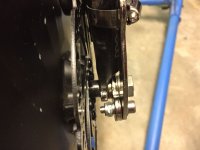I'm using a 240/350 watt front UrbanX wheel - not exactly sure of the wattage, it was used when I purchased it.
I have hydraulic brakes and a non-suspension steel fork.
I have attached a torque arm, c washer, an anti-rotation washer, and lock washers. I cannot fit washers between the hub and my fork, there's no space.
This is what happens:
If I go fast and brake hard, the front brake caliper goes slightly out of alignment or the wheel does - difficult to determine which.
Has anyone else experienced this?
What can I do to better secure the wheel and/or the front brake caliper?
Thanks!
I have hydraulic brakes and a non-suspension steel fork.
I have attached a torque arm, c washer, an anti-rotation washer, and lock washers. I cannot fit washers between the hub and my fork, there's no space.
This is what happens:
If I go fast and brake hard, the front brake caliper goes slightly out of alignment or the wheel does - difficult to determine which.
Has anyone else experienced this?
What can I do to better secure the wheel and/or the front brake caliper?
Thanks!


